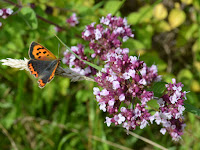Meadow butterflies
There’s been a lot of discussion this year about falling invertebrate numbers and we’ve shared these concerns.
Today, after lunch, we went down to the meadow with our coffee to monitor what was about.
The marjoram, wild carrot, purple loosestrife and ragwort are all in flower. Yellow rattle and cowslip now casting their seed.
 |
| Peacock on ragwort |
Marjoram is such great value in the meadow, even though it is getting bigger by the year and may become a bully. Bumble bees and honey bees were foraging on the flowers accompanied by butterflies and tiny wasps.
Delighted to see so many butterflies on the wing.
- Holly blue
- Meadow brown
- Gatekeeper
- Small copper
- Ringlet
- Small skipper
- Essex skipper
- Large white
- Green-veined white
- Red admiral
- Peacock
- Comma
- Small tortoiseshell
Our first record of Essex skipper.
And a common hawker crashing down in front of us to take a butterfly before carrying it off into the prairie beds to consume its meal.
 |
| Wild carrot in flower in meadow |
We now need to consider how we go forward with our meadow management.
Certain areas are close cut annually in early autumn after seed is cast.
Other areas are cut on a three-year cycle to establish a thick sward in the third year before a close cut to return us to the beginning of the cycle.
The third year thick sward is intended to be home for small mammals (voles, shrews, mice), amphibians and slow worms as well as overwintering for insect eggs and pupae. Seeding heads remain for birds.
At the end of the cycle our intention is to close cut and scarify to encourage new vegetation and seed germination. We can also add plug plants at this stage.
Arisings go into piles or windrows to provide habitat for wildlife.


